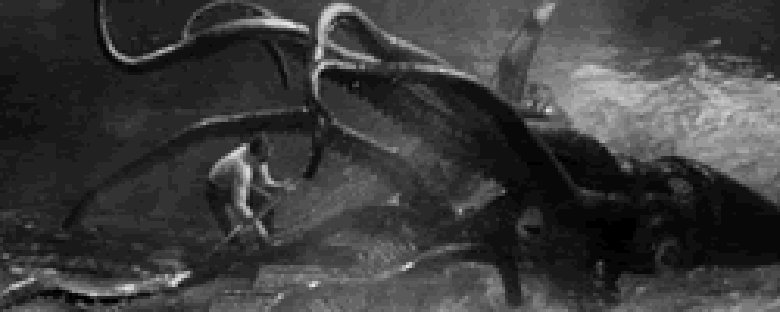Reviews
Befitted and promoted by great hype, the monster seen at the start of 20,000 Leagues Under the Sea is lent substantial attributes by a creative mass media. It is seen in the opening sequence: two glowing eyes a blur beneath rippled water, visible only when en route to a targeted ship it will shortly dissect. Afterwards, in newsprint lithographs, it inherits scales, wings, and a size that exceeds the ships it destroys.
Interest in this monster is abundant and varied: curators want to preserve it in a museum, captains want to lead its capture, and sailors want to bestow upon it the fate afforded by others in their rank. Each party has a similarly intense curiosity, one presumably mirrored by the film’s popularity with younger audiences. The actual horror of the monster downplayed (deaths are anonymous and bloodless), the film exploits such childish curiosity in its initial depiction of the sea monster. 20,000 Leagues is faithful to its Disney brand, trademarked with song and dance and the rescue of an innocent animal (here, a sea dog named Esmeralda, incidentally the primary female role in the film). It is also a sublime story of isolation, of disparate masculine seclusion, akin to those found in such films as Jaws and The Thing.
The monster is the Nautilus, an elaborately metaled submarine with a spine of iron thorns, engaged to puncture the bellies of ships. (This is no pirating tactic as any loot is used as ballast.) Its captain Nemo is a man of taste and sophistication, a philosopher and fine-witted individual whose intelligence finances his political aims: the ocean, says Nemo, is the last available freedom to man. Isolation, in this regard, is a masculine penchant, considering there are no women in the film. Reciprocal companionship and collaboration are limited to a single sex; this isolation limits the welfare of Nemo’s aims — his plan will fail because of this limit.
Outsiders immediately notice the flaws of this circumstance. Survivors of one attack — a professor, his assistant and a musically inclined sailor — locate the Nautilus amidst a fog, and are curiously welcomed as guests aboard Nemo’s vessel after a brief threat. In their first meal the men are treated to a dinner consisting entirely of meats and vegetables from the sea; it is a diet of exoticness and without variety. These men peer out the windows towards a terrain they have only imagined (the film successfully inherits the wonder of Jules Verne’s source text), incapable of routing their ties to land. Ned Land (the sailor), particularly, is the most restless of the three. He most successfully embodies traditional heroism with a costume that appears to have been made from an American flag. Ned is in dialectic opposition with Nemo, and is suggestively the more heroic and compassionate of the two men. In the final sequence, Ned lures Esmeralda away from her owner and the sinking Nautilus containing its crew and captain. The action clearly characterizes him as the film’s protagonist — a role I question given the justifiable benefit of Nemo’s agenda.
Nemo’s is a scheme in the pursuit of intellectual awakening that requires abandon. His misanthropy is fueled by Pacific slave trade (he primarily targets the industry’s ships). There is an apparent solace in his seclusion, yet respect for his aims is difficultly solicited and, more importantly, unshared. Professor Arronax (in a consistent Disney trend, the token “professor”) is a compatible thinker who is able to look past Nemo’s controversy. The professor’s optimism, however, disenables him from justifying his peer’s violence. Nemo’s philosophy is voiced in the dynamic chords of a pipe organ (heard in the film’s thematic climax), isolated and tragic deep beneath the ocean surface.
Despite a distinct resemblance to notable sea fictions as Jaws and Moby Dick, the film is unique for its violation of resilient thematic devices in both fictions. Significantly, Nemo has the obligatory sea nemesis (a giant squid) and, unlike his fictional peers, triumphs in his climactic battle — his success is due to his rescue, in a detail that underscores the flaws of his isolation. His hubristic downfall is due not to his conflict with the sea, as with Ahab and Quint, but with his fellow man. Captain Nemo is the most ambitiously intelligent of the three, and is among the most villainous of villains; his actions retain a great controversy, yet his motives are articulate and inviting.
Even after the expected fate of the Nautilus, its crew, and captain is secured, Nemo’s scheme persists in its questionability and benefit. His self-contained, self-financed expedition is for the benefit of exploration, science, and adventure. The film is entirely rousing despite the fact that misanthropy is the distinguishing trait of its central character’s motive — a character whose role as a villain seems appropriate yet is descriptively insufficient. Nemo succeeds at achieving the depth of the title, which tragically references the price of such success.
We don’t do comments anymore, but you may contact us here or find us on Twitter or Facebook.



